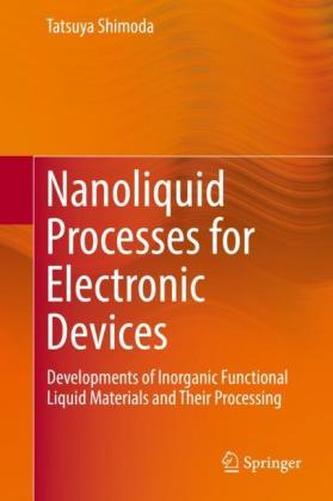Part I Introduction to liquid process
Chapter 1. Liquid process
1-1 Liquid and its formability
1-2 Categories of liquid process
1-2-1 First step: Conversion way from liquid to solid
1-2-2 Second step: Direct forming process
Part II Silicon-based materials
Chapter 2. Guide to...
prečítať celé
Part I Introduction to liquid process
Chapter 1. Liquid process
1-1 Liquid and its formability
1-2 Categories of liquid process
1-2-1 First step: Conversion way from liquid to solid
1-2-2 Second step: Direct forming process
Part II Silicon-based materials
Chapter 2. Guide to silicon-based materials
Chapter 3. Liquid silicon
3-1 CPS
3-1-1 Hydrosilanes and CPS
3-1-2 Structures of a CPS molecule
3-1-3 Electronic structure of isolated CPS molecule
3-1-4 Interaction between CPS molecules
3-2 Silicon ink
3-2-1 Silicon ink from CPS
3-2-2 Polymer structure in silicon ink
3-3-3 Doped silicon inks
Chapter 4. Thin film formation by coating
4-1 Coating process and molecular forces
4-2 The origin of molecular forces
4-2-1 Theory of van der Waals free energy
4-2-2 Measurement of refractive index n
4-2-3 Molecular forces of CPS and silicon compounds
4-3 Coating of Si ink
4-3-1 General remarks on Si ink coating
4-3-2 Observations of liquid films
4-3-3 Hamaker constant and coating property
4-4 Conversion from polysilane to amorphous Si by pyrolysis
4-4-1 Film appearance during pyrolysis and TG/DTA analysis of Si ink
4-4-2 Raman scattering analysis
4-4-3 FT-IR and SIMS analyses
4-4-4 Properties of amorphous films
Chapter 5. Liquid vapor deposition using liquid silicon (LVD)
5-1 Formation of i, n and p type silicon film by LVD
5-1-1 LVD method and experiment
5-1-2 CPS deposition process
5-1-3 Film properties
5-1-4 Conclusion
5-2 High-quality amorphous silicon film with LVD
5-2-1 New equipment for LVD
5-2-2 Film quality with processing temperature
5-2-3 Film quality with CPS supply speed
5-2-4 Electronic properties of a-Si:H films
5-2-5 Oxygen contamination in a-Si:H film
5-2-6 Summary
Chapter 6. Liquid silicon family materials (1)
-- SiO 2 , CoSi 2 and Al from liquid Si --
6-1 SiO 2 fabrication from liquid silicon
6-1-1 Forming SiO 2 films from liquid silicon material
6-1-2 The sole solution-processed SiO 2 film for TFTs
6-1-3 Multi use of solution-processed SiO 2 films for TFTs
6-1-4 Conclusion
6-2 CoSi 2 fabrication from liquid silicon
6-2-1 Metal silicide from solution
6-2-2 Synthesis of cobalt silicide ink
6-2-3 Formation of CoSi 2 films
6-2-4 TEM observation
6-2-5 Comparison of this process with the conventional ones
6-2-6 More detailed analyses
6-2-7 Conclusions
6-3 Al fabrication via solution process
6-3-1 Triethylamine alane as a precursor of metal Al
6-3-2 Deposition process and reaction
6-3-3 Analysis of film structure and Al growth manner
6-3-4 Selective deposition of Al
6-3-5 Conclusion
Chapter 7. Liquid silicon family materials (2)
-- SiC ink and SiC film from liquid Si --
7-1 SiC fabrication via liquid process
7-1-1 Preparation and characterization of SiC precursor polymer
7-1-2 a-SiC film formation and analyses of films
7-1-3 Polymer structure
7-1-4 Polymer-to-ceramic conversion
7-1-5 Conclusion
7-2 Correlation of Si/C stoichiometry between SiC ink and a-SiC film
7-2-1 Polymer and film preparation
7-2-2 Correlation between PSH and a-SiC
7-2-3 Structural properties of an a-SiC film
7-2-4 Optical and electrical properties of an a-SiC film
7-2-5 Conclusion
7-3 n-type a-SiC by coating
7-3-1 Polymer and film preparation and their analyses
7-3-2 Polymer analysis
7-3-3 Thin-film formation
7-3-4 Effect of carbon content on film
7-3-5 Effect of phosphorous concentration on film
7-3-6 Conclusion
7-4 p-type a-SiC via LVD method
7-4-1 SiC-ink preparation and film deposition
7-4-2 Ink analysis
7-4-3 Film analysis
7-4-4 Discussion
7-4-5 Conclusion
Chapter 8. Nano pattern formation using liquid silicon
8-1 Area selective deposition of silicon family materials
8-1-1 Area selective deposition of silicon using the difference of molecular force
8-1-
Skryť popis





Recenzie